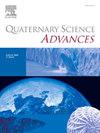Cueva del Arco:旧石器时代景观的古生态学见解
IF 2.2
Q2 GEOGRAPHY, PHYSICAL
引用次数: 0
摘要
本文介绍了来自Cueva del Arco的新数据,并提供了一个全面的视角来研究在Mousterian和Gravettian时期,尼安德特人和智人在西班牙东南部穆尔西亚内陆居住的古环境。我们关注史前景观的生态结构和植物区系组成,利用粪化石和洞穴沉积物中的花粉记录,以及木炭和植物大残骸,特别是种子。从埋藏学和古生态学的角度来讨论脊椎动物的组合。我们的研究结果表明,尽管气候波动,在MIS 3期间,Cueva del Arco周围的景观只发生了有限的变化,可能受到附近冰川要塞的缓冲,例如塞古拉-卡索拉-阿尔卡拉斯山脉的直接河流水文避难所和生物多样性水库。我们强调了目前不同生物气候亲缘性的植物物种共存,表明植被带的压缩。局部地区,在岩溶基岩上的岩石层的影响下,景观保持开阔,在较深的土壤上散布着树木或小树林。值得注意的是,柏科是当地植被的主要特征,也是重要的柴火资源,支持人类适应环境。在这种具有弹性和生态多样性的环境中,旧石器时代的人们可以获得各种各样的动植物资源,这些资源对他们的生存至关重要。本文章由计算机程序翻译,如有差异,请以英文原文为准。
Cueva del Arco: Paleoecological insights into Paleolithic landscapes
This article presents new data from Cueva del Arco and offers a comprehensive perspective on the palaeoenvironments inhabited by Neanderthals and Homo sapiens in the interior of Murcia, southeastern Spain, during the Mousterian and Gravettian periods. We focus on the ecological structure and floristic composition of prehistoric landscapes, drawing on pollen records from coprolites and cave sediments, as well as charcoal and plant macroremains, particularly seeds. Vertebrate assemblages are discussed through taphonomic and paleoecological lenses. Our results show that the landscapes surrounding Cueva del Arco during MIS 3 underwent only limited changes despite climatic fluctuations, likely buffered by nearby glacial strongholds, such as immediate riverine hydrorefugia and biodiversity reservoirs in the Segura-Cazorla-Alcaraz Mountains. We highlight the coexistence of plant species with currently disparate bioclimatic affinities, suggesting a compression of vegetation belts. Locally, under the edaphic influence of lithosols overlying karstic bedrock, the landscape remained open, with scattered trees or small groves on deeper soils. Notably, Cupressaceae were a dominant feature of the local vegetation and constituted a critical resource for firewood, supporting human adaptation to the environment. In this resilient and ecologically diverse setting, Paleolithic populations had access to a wide variety of plant and animal resources essential for their survival.
求助全文
通过发布文献求助,成功后即可免费获取论文全文。
去求助
来源期刊

Quaternary Science Advances
Earth and Planetary Sciences-Earth-Surface Processes
CiteScore
4.00
自引率
13.30%
发文量
16
审稿时长
61 days
 求助内容:
求助内容: 应助结果提醒方式:
应助结果提醒方式:


